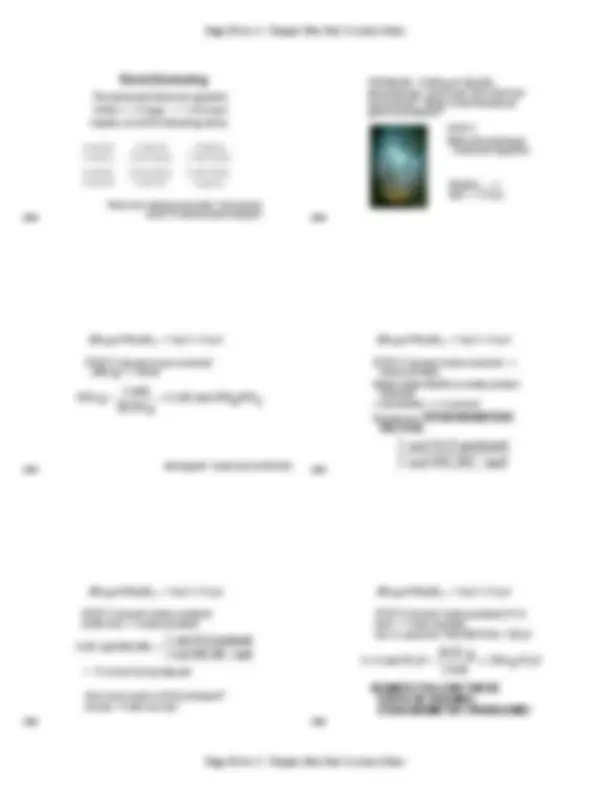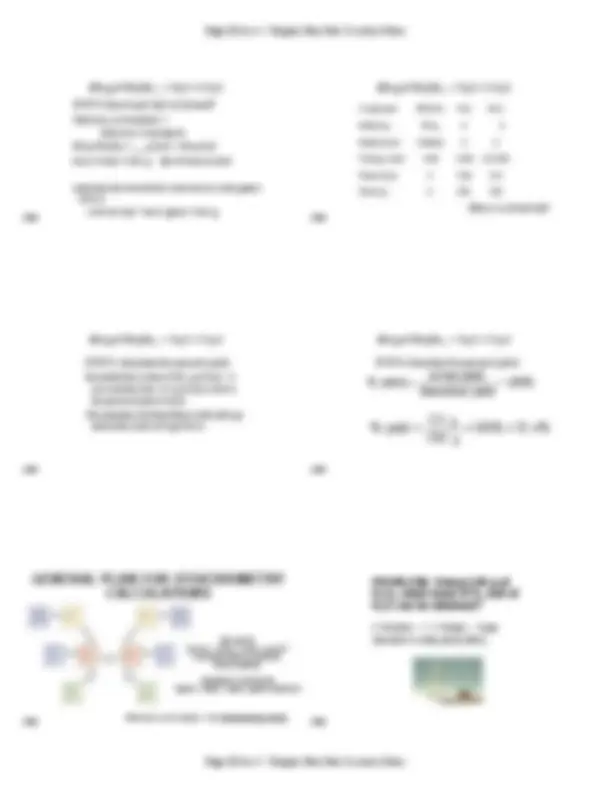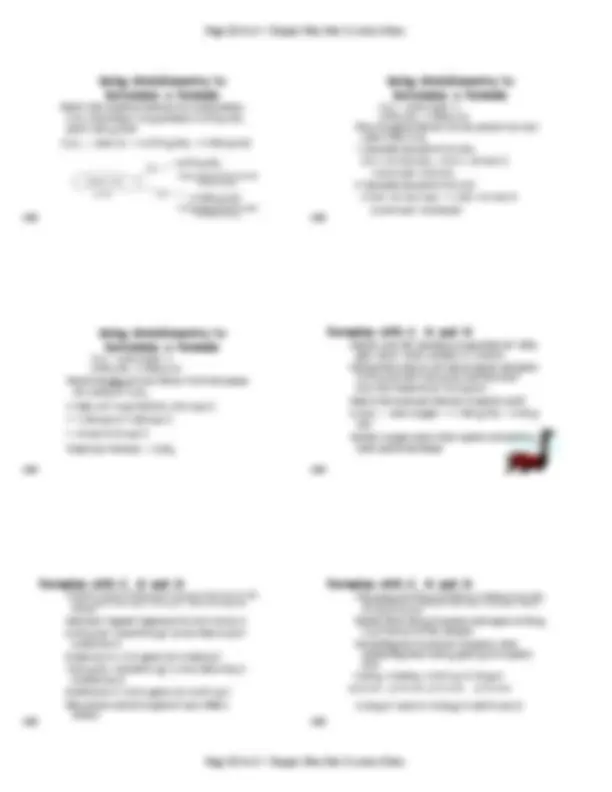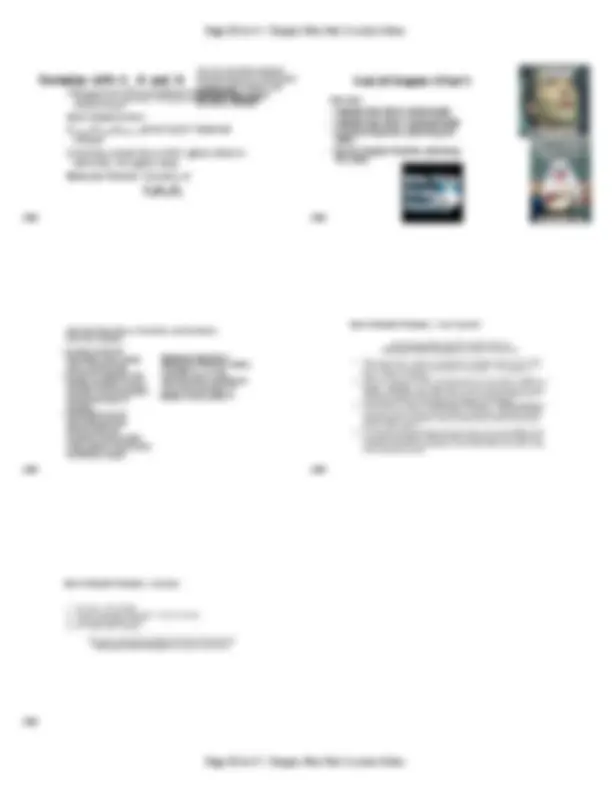







Study with the several resources on Docsity

Earn points by helping other students or get them with a premium plan


Prepare for your exams
Study with the several resources on Docsity

Earn points to download
Earn points by helping other students or get them with a premium plan
Community
Ask the community for help and clear up your study doubts
Discover the best universities in your country according to Docsity users
Free resources
Download our free guides on studying techniques, anxiety management strategies, and thesis advice from Docsity tutors
An in-depth explanation of stoichiometry and chemical reactions, including balancing equations, theoretical and actual yields, limiting reactants, and determining empirical and molecular formulas. Examples and calculations are provided throughout.
Typology: Lecture notes
1 / 9

This page cannot be seen from the preview
Don't miss anything!






Chapter 4 Part 1
MAR
Reactants: Zn + I 2 Product: ZnI 2 Chemistry 221 Professor Michael Russell Last update: 8/9/
Chemistry as Cooking! - the Chemical Reaction "Recipe" and technique leads to successful creations Must know amounts to add, how much will be produced Haphazard additions can be disastrous!
MAR
Chemical Equations
MAR
Reaction of Phosphorus with Cl 2
MAR
Reaction of Iron with Cl 2
MAR
Evidence of a chemical reaction: heat change, precipitate formation, gas evolution, color change
Chemical Equations
4 Al(s) + 3 O 2 (g) → 2 Al 2 O 3 (s) This equation means:
4 Al atoms + 3 O 2 molecules ---give---> 2 molecules of Al 2 O 3 or 4 moles of Al + 3 moles of O 2 ---give--->
MAR^ 2 moles of Al^2 O^3
MAR
Chemical Equations
Because of the principle of the conservation of matter,
It must have the same number of atoms of the same kind on both sides.
Lavoisier, 1788
Chemical Equations / Lavoisier
MAR
Balancing Equations
_ Al(s) + _ Br 2 (liq) ---> _ Al 2 Br 6 (s)
MAR
2 Al(s) + 3 Br 2 (liq) ---> Al 2 Br 6 (s)
Balancing Equations
____C 3 H 8 (g) + _____ O 2 (g) ----> _____CO 2 (g) + _____ H 2 O(g)
____B 4 H 10 (g) + _____ O 2 (g) ----> ___ B 2 O 3 (g) + _____ H 2 O(g)
MAR
C 3 H 8 (g) + 5 O 2 (g) ----> 3 CO 2 (g) + 4 H 2 O(g)
2 B 4 H 10 (g) + 11 O 2 (g) ----> 4 B 2 O 3 (g) + 10 H 2 O(g)
Balancing Equations - Hints
MAR
STOICHIOMETRY
Stoichiometry is the study of the quantitative aspects of chemical reactions. Stoichiometry rests on the principle of the conservation of matter. MAR
Total mass of reactants = total mass of products 454 g NH 4 NO 3 = ___ g N 2 O + 204 g H 2 O mass of N 2 O = 250. g law of mass action!
could also turn mol NH 4 NO 3 into mol N 2 O, then grams of N 2 O:
MAR^ 5.68 mol N^2 O * 44.01 g/mol = 250. g
MAR
Compound NH 4 NO 3 N 2 O H 2 O
Initial (g) 454 g 0 0
Initial (mol) 5.68mol 0 0 Change (mol) -5.68 +5.68 +2(5.68)
Final (mol) 0 5.68 11. Final (g) 0 250. 204
We predicted a yield of 250. g of N 2 O. If you isolated only 131 g of N 2 O, what is the percent yield of N 2 O? This compares the theoretical yield (250. g) and actual yield (131 g) of N 2 O.
MAR
MAR
% yield =
actual yield theoretical yield
% yield =
131 g
- 100% = 52.4% GENERAL PLAN FOR STOICHIOMETRY CALCULATIONS
MAR Molarity in next chapter - See^ Stoichiometry Guide
We use the "grams - moles - moles - grams" conversion often in chemistry (mass is grams) Sometimes I call this the "grams - moles - moles - grams" dance lol
2 H 2 O 2 (liq) ---> 2 H 2 O(g) + O 2 (g) Reaction is catalyzed by MnO 2
MAR
2 H 2 O 2 (liq) ---> 2 H 2 O(g) + O 2 (g) Reaction is catalyzed by MnO 2 Step 1: moles of H 2 O 2 Step 2: use STOICHIOMETRIC FACTOR to calculate moles of O 2 Step 3: mass of O 2 (2.35 g) Step 4: mass of H 2 O (2.65 g) Try this problem yourself! MAR
Reactions Involving a LIMITING REACTANT
MAR
LIMITING REACTANTS
MAR
LIMITING REACTANTS
MAR
R eactants Products
LIMITING REACTANTS React solid Zn with 0.100 mol HCl (aq)
Zn(s) + 2 HCl(aq) ---> ZnCl (^) 2(aq) + H2(g)
Left: Balloon inflates fully, some Zn left
Left Center Right mass Zn (g) 7.00 3.27 1. mol Zn 0.107 0.050 0. mol HCl 0.100 0.100 0. mol HCl/mol Zn 0.93 2.00 5. Lim Reactant LR = HCl no LR LR = Zn
LIMITING REACTANTS React solid Zn with 0. mol HCl (aq) Zn(s) + 2 HCl(aq) ---> ZnCl (^) 2(aq) + H2(g) 0.100 mol HCl [1 mol Zn/2 mol HCl] = 0.0500 mol Zn
MAR
moles Cl 2
moles Al 2 Cl 6
grams Cl 2
grams Al 2 Cl 6
1 mol Al 2 Cl 6 3 mol Cl 2
Step 1: Calculate moles of Al 2 Cl 6 expected using chlorine:
MAR
Step 2: Calculate mass of Al 2 Cl 6 expected based on chlorine:
0.0380 mol Al 2 Cl 6 • 266.4 g Al^2 Cl^6 mol
= 10.1 g Al 2 Cl (^6)
MAR
Calculate theoretical yield of product based on both reactants. Smaller theoretical yield comes from limiting reactant, greater yield from excess reactant.
10.1 g < 26.6 g , so: limiting reactant = Cl 2 , theoretical yield = 10.1 g, excess reactant = Al
8.10 g Cl 2 • 1 mol 70.9 g
= 10.1 g Al 2 Cl (^6)
5.40 g Al • 1 mol 27.0 g
= 26.6 g Al 2 Cl (^6)
Excess Al = Al available - Al required = 5.40 g - 2.05 g = 3.35 g Al unused in reaction
8.10 g Cl 2 • 1 mol 70.9 g
= 2.05 g Al
Hydrocarbons, Cx H (^) y , can be burned in oxygen to give CO 2 and H 2 O (combustion reaction). The CO 2 and H 2 O can be collected to determine the empirical formula of the hydrocarbon. Cx H (^) y + O 2 ---> CO 2 + H 2 O
MAR
What is the empirical formula of a hydrocarbon, Cx H (^) y , if burning 0.115 g produces 0.379 g CO 2 and 0.1035 g H 2 O? Cx H (^) y + some O 2 ---> 0.379 g CO 2 + 0.1035 g H 2 O
MAR
Puddle of Cx H (^) y 0.115 g
+O 2 0.379 g CO 2
+O (^2) 0.1035 g H 2 O 1 H 2 O molecule forms for each 2 H atoms in Cx H (^) y
1 CO 2 molecule forms for each C atom in C (^) x H (^) y
First , recognize that all C in CO 2 and all H in H 2 O comes from C (^) x H (^) y.
C (^) x H (^) y + some oxygen ---> 0.379 g CO 2 + 0.1035 g H 2 O
MAR
C (^) x H (^) y + some oxygen ---> 0.379 g CO 2 + 0.1035 g H 2 O
Caproic acid, the substance responsible for "dirty gym socks" smell, contains C, H and O. Combustion analysis of 0.450 g caproic acid gives 0.418 g H 2 O and 1.023 g CO 2 , and the molar mass was found to be 116.2 g mol-^. What is the molecular formula of caproic acid? C (^) x H (^) y Oz + some oxygen ---> 1.023 g CO 2 + 0.418 g H 2 O Careful: oxygen comes from caproic acid and O 2 , need special technique
MAR
Combustion analysis of 0.450 g caproic acid gives 0.418 g H 2 O and 1. g CO 2 , and the molar mass is 116.2 g mol-1^. What is the molecular formula? Start with "regular" approach for mol H & mol C: 0.418 g H 2 O * (mol/18.02 g) * (2 mol H/mol H 2 O) = 0.0464 mol H 0.0464 mol H * (1.01 g/mol H) = 0.0469 g H 1.023 g CO 2 * (mol/44.01 g) * (1 mol C/mol CO 2 ) = 0.02324 mol C 0.02324 mol C * (12.01 g/mol C) = 0.2791 g C Why did we convert to grams? Law of Mass Action! MAR
0.450 g caproic acid: 0.418 g H 2 O (0.0464 mol H, 0.0469 g H) and 1.023 g CO 2 (0.02324 mol C, 0.2791 g C), molar mass = 116.2 g/mol. What is the molecular formula? Realize that 0.450 g of caproic acid equals all the g C, g H and g O in the complex. Converting mol H and mol C to grams, then subtracting from 0.450 g, gives g O in caproic acid: 0.450 g - 0.0469 g - 0.2791 g = 0.124 g O
MAR
caproic acid g of H in acid g of C in acid g of O in acid
0.124 g O * (mol O / 16.00 g) = 0.00775 mol O